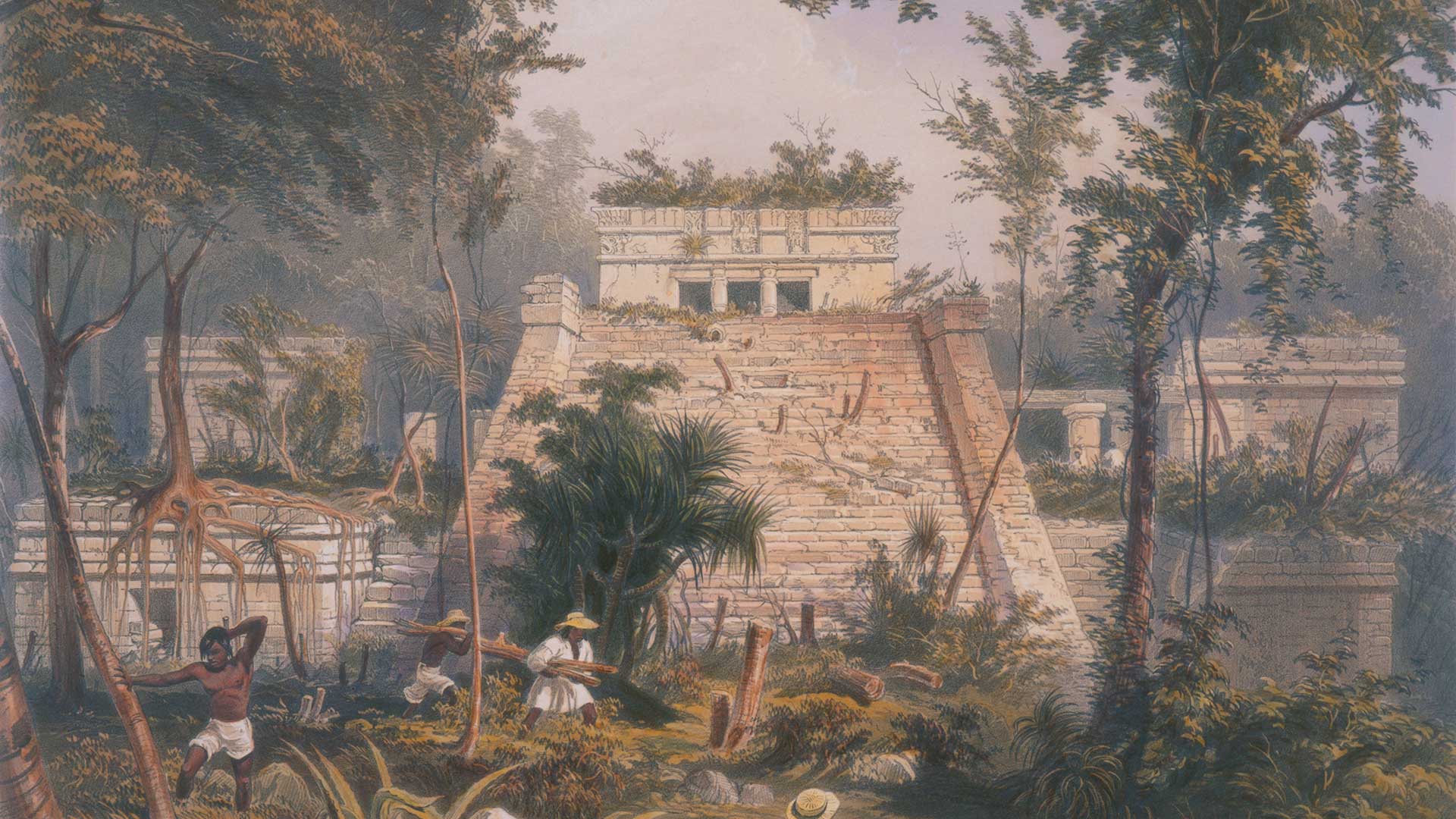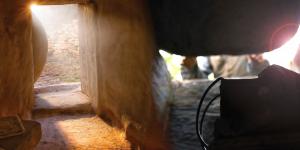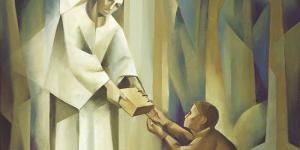You are here
Why Did the Lord Command the Three Witnesses to Rely upon His Word?

D&C 17:1
The Know
In June 1829, Oliver Cowdery, David Whitmer, and Martin Harris became the Three Witnesses of the Book of Mormon. They testified that they saw an angel, who showed them the golden plates from which the Book of Mormon was translated. They also testified that they had heard the voice of God declare that the translation of the record was accomplished by the gift and power of God and they were commanded to bear record of it.1 Unbeknownst to most who read the witnesses’ official statement, however, David Whitmer indicated late in his life that he and his fellow witnesses were initially reluctant to publish their testimony to the world.
According to James H. Hart, David recalled in 1883, “When we were first told to publish our statement, we felt sure the people would not believe it, for the Book [of Mormon] told of a people who were refined and dwelt in large cities.”2 For this reason, David said that he and Oliver actually “demurred and told the Lord the people would not believe” their testimony. They apparently did not think the earthen mounds familiar to anybody living in upstate New York at that time accounted for the book’s testimony “of a people who were educated and refined, dwelling in large cities.” Instead, reflecting common prejudices of the day, the witnesses felt that the only known “early inhabitants of this country” were “filthy, lazy, degraded and ignorant savages that were roaming over the land.”3
In response to these concerns, David said, “the Lord told us that He would make it known to the people, and people should discover the ruins of the lost cities and abundant evidence of the truth of what is written in the Book.”4 Evidently placated by this assurance, the witnesses drafted and signed a statement testifying not only that they had seen the angel and the plates, but also that they knew “of a surety that the work is true.”5 The Book of Mormon went to press a few months later, and on March 26, 1830 the first copies went up for sale in E. B. Grandin’s bookshop in Palmyra, New York.
About a year later, Anglo-Irish diplomat Juan Galindo visited the ruins of Palenque in Chiapas, Mexico.7 Struck by the impressive ruins which sprawled for 20 miles, and inscriptions written with “characters very neatly executed,” Galindo wrote a letter to The London Literary Gazette reporting that the discovery “rescue[d] ancient America from a charge of barbarism.”7 Galindo was not actually the first European to visit Palenque; Spanish military captain Jose Antonio del Rio and artist Ricardo Almendariz explored the site in the late 18th century. Del Rio’s report, initially written in Spanish, was first published in English in 1822, but was met with skepticism and remained little known.8 Thus, despite del Rio’s earlier report, the Gazette’s editor considered Galindo’s account a revelation of “a place utterly unknown to European geography and antiquities.”9
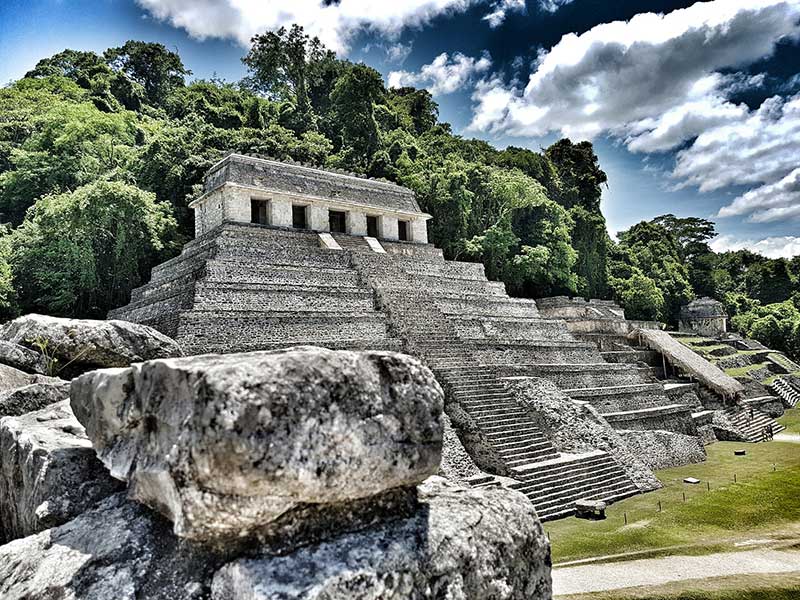
Ruins of a pyramid in Palenque in Chiapas, Mexico. Image via Pixabay.
The Three Witnesses may have seen this as the first indication that the Lord’s promise to them was being fulfilled. Under the editorship of W. W. Phelps and Oliver Cowdery, The Evening and Morning Star (the official paper of the Church from 1832–1834) reported on Galindo’s findings, adding the remarks, “We are glad to see the proof begin to come, of the original or ancient inhabitants of this continent. It is good testimony in favor of the book of Mormon, and the book of Mormon is good testimony that such things as cities and civilization … existed in [pre-Columbian] America.”10 The witnesses had been assured that evidence for lost cities would come forth to support the account in the Book of Mormon, so the Evening and Morning Star emphasized how Galindo’s account supports the Book of Mormon’s testimony of “cities and civilization.”
About a decade later, John Lloyd Stephens and Fredrick Catherwood published a vividly illustrated and dramatically told account of their travels among the ruins of Central America.11 Despite earlier reports, such as those by Galindo, it was the publication of Stephens and Catherwood’s accounts in the 1840s that gave the world its first real glimpse of the advanced civilization that once existed on the American continent.12
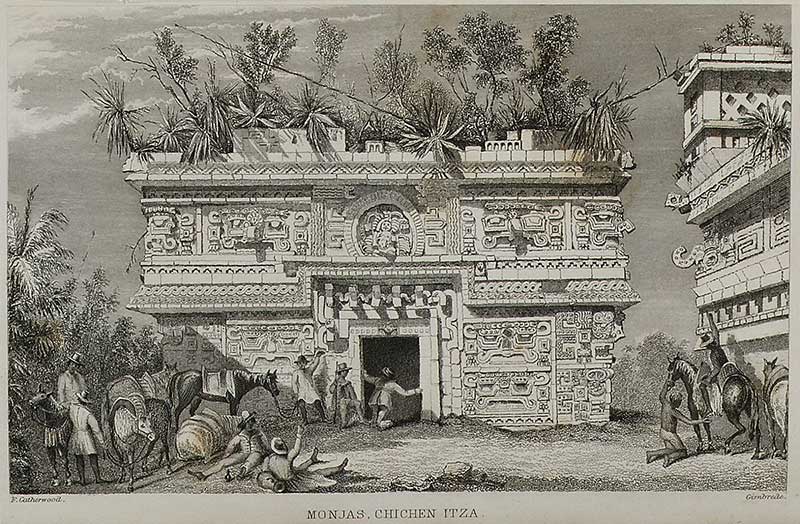
Drawing by Frederick Catherwood of travels in Central America. Image via Met Museum.
Like other Americans at the time, Latter-day Saints were fascinated by the findings.13 John Bernhisel, a recent convert in New York, gifted a copy of Stephens and Catherwood’s books to the prophet Joseph Smith.14 Wilford Woodruff read them as he carried them from New York to Nauvoo, and remarked, “I felt truly interested in this work for it brought to light a flood of testimony in proof of the book of Mormon.”15 Likewise, Joseph Smith wrote back to Bernhisel stating, “I have read the volumes with the greatest interest,” adding that the account “corresponds with & supports the testimony of the Book of Mormon.”16
From June 1841 to December 1844, Stephens and Catherwood were cited 10 different times—including 5 times while Joseph Smith was editor—as evidence for the Book of Mormon in the Church’s flagship newspaper, the Times and Seasons.17 Several additional references to Stephens and Catherwood appeared in other Latter-day Saint writings during this same time-period.18 Throughout the 19th century, Latter-day Saints continued to value the evidence Stephens and Catherwood provided for large cities and high civilization in ancient America.19
The Why
In 1875, a writer for the Chicago Times remembered David Whitmer “referring to the innumerable evidences, in the shape of ruins of great cities existing on this continent, of its former occupation by a highly civilized race” as he testified of the Book of Mormon.20 In 1829, however, little evidence of such high civilization existed, and this caused David and Oliver some concern—even as they witnessed an angel showing them the plates. It was as the Lord said: they had to have faith and rely on His word (D&C 17:1; cf. D&C 5:12).
But the Lord also promised that His “word shall be verified” (D&C 5:20) and He would “bring to light” the “marvelous works” of his “other sheep” (D&C 10:60–61). David remembered that the Lord promised that others would be divinely led to “discover the ruins of the great cities, and they should have abundant evidence of the truth of that which is written in the book.” In the twilight of his life, David said that had all “been fulfilled to the very letter.”21
For readers today, this little known, but inspiring, aspect of the Three Witnesses’ story can teach many lessons. First and foremost, it serves as a reminder that the Lord fulfills His promises. Such fulfillment does not always come right away—sometimes years, decades, and even generations pass away before the Lord’s promises are fulfilled. When this is the case, the faithful must have patience and rely on God’s word, just as the Book of Mormon Witnesses did.
Second, it illustrates why even those who see visions of angels must ultimately have faith. David and Oliver saw an angel, they saw the plates, and they heard the voice of God—but they still had to exercise faith in the Lord to testify of the truth of the Book of Mormon’s account of cities and high civilization in ancient America, for which there was little evidence at the time.
Third, it shows that early Latter-day Saints, including Joseph Smith himself, were not opposed to viewing the events of the Book of Mormon as having taken place outside the United States. Throughout the history of the Church of Jesus Christ of Latter-day Saints, its leaders and members have held a diversity of opinions regarding matters of Book of Mormon geography.22 Today, “The Church does not take a position on the specific geographic locations of Book of Mormon events,” other than that they transpired somewhere “in the ancient Americas.”23
Fourth, it demonstrates the need for patience when current knowledge from archaeology or ancient history conflicts with scripture. In addition to the existence of cities and high civilization in ancient America—little known in 1829, but widely accepted today—dozens of other details once thought to be anachronistic in the Book of Mormon have since been confirmed by archaeological discovery.24 While some things remain unconfirmed, the archaeological evidence trends favorably for the Book of Mormon.
This ongoing trend shows that God’s promise to the Three Witnesses continues to be fulfilled today and increasing archaeological evidence supports the Book of Mormon. It also gives people today reason to exercise faith when confronting questions that, for now, remain unanswered about ancient scripture.
Further Reading
Matt Roper and Kirk Magleby, “Time Vindicates the Prophet,” 2019 FairMormon Conference Presentation, August 2019, online at fairmormon.org.
Matthew Roper, “John Bernhisel’s Gift to a Prophet: Incidents of Travel in Central America and the Book of Mormon,” Interpreter: A Journal of Mormon Scripture 16 (2015): 207–253.
Neal Rappleye, “‘War of Words and Tumult of Opinions’: The Battle for Joseph Smith’s Words in Book of Mormon Geography,” Interpreter: A Journal of Mormon Scripture 11 (2014): 37–95.
Matthew Roper, Paul J. Fields, and Atul Nepal, “Joseph Smith, the Times and Seasons, and Central American Ruins,” Journal of Book of Mormon Studies 22, no. 2 (2013): 84–97.
John E. Clark, “Archaeological Trends and Book of Mormon Origins,” in The Worlds of Joseph Smith: A Bicentennial Conference at the Library of Congress, ed. John W. Welch (Provo, UT: BYU Press, 2006), 83–106.
- 1. Testimony of Three Witnesses, front of the Book of Mormon.
- 2. See James H. Hart Interview, August 21, 1883, James H. Hart Notebook, in David Whitmer Interviews: A Restoration Witness, ed. Lyndon W. Cook (Orem, UT: Grandin Book Co., 1991), 96.
- 3. James H. Hart to Editor, August 23, 1883, in Deseret Evening News, September 4, 1883, in David Whitmer Interviews, 98.
- 4. Hart Interview, in David Whitmer Interviews, 96.
- 5. Testimony of Three Witnesses, front of the Book of Mormon.
- 7. a. b. See David Drew, The Lost Chronicles of the Maya Kings (Berkeley and Los Angeles, CA: University of California Press, 1999), 50–52.
- 8. See Jose Antonio del Rio, Description of the Ruins of an Ancient City, Discovered near Palenque, in the Kingdom of Guatemala, in Spanish America, trans. Paul Felix Cabrera (London: Henry Berthoud, 1822). A review of del Rio’s book in The London Literary Gazette and Journal of Belles Lettres, Arts, Sciences, etc. 303 (November 9, 1822): 705 declared it “about as fanciful an antiquarian hypothesis as we ever met with.” The review goes on to say, “To talk of medallions, figures in stucco, relievos, devices, etc. etc. at the assigned period, is little short of the grossest absurdity.” Drew, Lost Chronicles, 45–46 notes that after del Rio’s report was published in English, “interest in the book was slow to pick up.”
- 9. Editorial note, Galindo to the Editor, 665.
- 10. “Discovery of Ancient Ruins in Central America,” in The Evening and Morning Star 1, no. 9 (February 1833): 142. The paper was published by “W. W. Phelps & Co.,” the corporate name for the Church’s printing company in Missouri, which included W. W. Phelps, John Whitmer, and Oliver Cowdery. See “W. W. Phelps & Co.,” at josephsmithpapers.org. Oliver Cowdery assisted Phelps “in conducting [the] church’s printing operations at Jackson Co., Missouri, 1832–1833.” See “Cowdery, Oliver,” at josephsmithpapers.org. After Phelps’ printshop was destroyed in Missouri, Oliver and Fredrick G. Williams reprinted each issue of the Evening and Morning Star in Kirtland, so this article appeared twice in print, once in Independence and again in Kirtland.
- 11. John L. Stephens and Frederick Catherwood, Incidents of Travel in Central America, Chiapas, and Yucatan, 2 vols. (New York City, NY: Harper and Brothers, 1841). See also William Carlsen, Jungle of Stone: The True Story of Two Men, Their Extraordinary Journey and the Discovery of the Lost Civilization of the Maya (New York, NY: William Morrow, 2016).
- 12. See Drew, Lost Chronicles, 2; Carlsen, Jungle of Stone, ix–xi.
- 13. The earliest documented reference to Stephens and Catherwood in defense of the Book of Mormon by a Latter-day Saint is Erastus Snow, “E. Snow’s Reply to the Self-Styled Philanthropist of Chester County,” ca. November 1840, 2–3. A few months later, the Times and Seasons, under the editorship of Don Carlos Smith and Robert B. Thompson, cited Stephens and Catherwood as evidence for the Book of Mormon (see n.17).
- 14. John M. Bernhisel to Joseph Smith, September 8, 1841, in Brent M. Rogers et al., Joseph Smith Papers—Documents, volume 8: February–November 1841 (Salt Lake City, UT: Church Historian’s Press, 2019), 261. See also Matthew Roper, “John Bernhisel’s Gift to a Prophet: Incidents of Travel in Central America and the Book of Mormon,” Interpreter: A Journal of Mormon Scripture 16 (2015): 207–253.
- 15. Wilford Woodruff Journal, 13 September, 1841, in Scott G. Kenney, ed., Wilford Woodruff’s Journal (Salt Lake City, UT: Signature Books, 1983), 2:126.
- 16. Joseph Smith to John M. Bernhisel, November 16, 1841, in Rogers et al., JSP–D 8:367. Some who are committed to the view that Joseph Smith knew by revelation that the Book of Mormon took place in the American “heartland” claim that Joseph Smith did not actually author this letter because it is in the handwriting of John Taylor. However, there is no merit to this view. Joseph Smith regularly dictated his letters to scribes who wrote for him, but this does not make Joseph any less responsible for the content of the letters. This letter is part of an extended correspondence with Bernhisel and continues to discuss business matters mentioned in previous letters, including details Taylor (who was not the scribe for other letters) would not likely have known. Thus, it is highly unlikely that Joseph was not responsible for the contents of this letter. See Matthew Roper, “Joseph Smith, Central American Ruins, and the Book of Mormon,” in Approaching Antiquity: Joseph Smith and the Ancient World, ed. Lincoln H. Blumell, Matthew J. Grey and Andrew H. Hedges (Salt Lake City and Provo, UT: Deseret Book and BYU Religious Studies Center, 2015), 142–143; Matthew Roper, “Joseph Smith, Revelation, and Book of Mormon Geography,” FARMS Review 22, no. 2 (2010): 74 for more discussion of this issue.
- 17. See “American Antiquities—More Proofs of the Book of Mormon,” Times and Seasons 2, no. 16 (June 15, 1841): 440–442; “Traits of the Mosaic History,” Times and Seasons 3, no. 16 (June 15, 1842): 818–820; “American Antiquities,” Times and Season 3, no. 18 (July 15, 1842): 858–860; “Extract from Stephens’ ‘Incidents of Travel in Central America,’ ” Times and Seasons 3, no. 22 (September 15, 1842): 911–915; “Facts Are Stubborn Things,” Times and Seasons 3, no. 22 (September 15, 1842): 921–922; “Zarahemla,” Times and Seasons 3, no. 23 (October 1, 1842): 927–928; “Letter of Orson Spencer,” November 17, 1842, in Times and Seasons 4, no. 4 (January 2, 1843): 51; “Ancient Records,” Times and Seasons 4, no. 12 (May 1, 1843): 185–186; “Stephens’ Work on Central America,” Times and Seasons 4, no. 22 (October 1, 1843): 346; “Ancient Ruins,” Times and Seasons 5, no. 1 (January 1, 1844): 390–391; William Smith to W. W. Phelps, November 10, 1844, Times and Seasons 5, no. 23 (December 15, 1844): 755–757. The authorship of the editorials published during Joseph Smith’s editorship, as well as Joseph’s level of involvement as editor, is disputed by those who believe Joseph Smith knew by revelation that the Book of Mormon took place in the American “heartland.” The best available historical and linguistic evidence, however, indicates that Joseph Smith was involved as editor of the Times and Seasons and helped write these editorials. See Matthew Roper, Paul J. Fields, and Atul Nepal, “Joseph Smith, the Times and Seasons, and Central American Ruins,” Journal of Book of Mormon Studies 22, no. 2 (2013): 84–97; Neal Rappleye, “‘War of Words and Tumult of Opinions’: The Battle for Joseph Smith’s Words in Book of Mormon Geography,” Interpreter: A Journal of Mormon Scripture 11 (2014): 37–95; Matthew Roper, Paul Fields, and Larry Bassist, “Zarahemla Revisited: Neville’s Newest Novel,” Interpreter: A Journal of Mormon Scripture 17 (2016): 13–61.
- 18. See “Ruins in Central America,” Latter-day Saints’ Millennial Star 2, no. 11 (March 1842): 161–165; John E. Page, “Mormonism – Concluded,” Morning Chronicle (Pittsburgh, PA) 1, no. 290 (July 20, 1842).
- 19. See, for example, Orson Pratt, “Divine Authority; or the Question, Was Joseph Smith Sent of God?” (Liverpool: R James, September 30, 1848); George Q. Cannon, “Buried Cities of the West,” Later-day Saints’ Millennial Star 19, no. 2 (January 10, 1857); Edward Stevenson, Reminiscences of Joseph, the Prophet, and the Coming Forth of the Book of Mormon (Salt Lake City, UT: Published by the Author, 1893), 16.
- 20. “David Whitmer,” Chicago Times, August 7, 1875, in David Whitmer Interviews, 5.
- 21. Hart to Editor, in David Whitmer Interviews, 98.
- 22. See John L. Sorenson, The Geography of Book of Mormon Events: A Source Book (Provo, UT: FARMS, 1992); Matthew Roper, “Limited Geography and the Book of Mormon: Historical Antecedents and Early Interpretations,” FARMS Review 16, no. 2 (2004): 225–276.
- 23. See “Book of Mormon Geography,” Gospel Topics, online at churchofjesuschrist.org. This means that even though many early Church leaders, including Joseph Smith, viewed ruins from Mesoamerica as being relevant to the Book of Mormon’s setting, their views are not considered as authoritative or binding upon Church members today. The same would hold true of any statements or views made by past leaders that would seem to support any other geographic model or setting. This is simply not a matter that can be settled by an appeal to prophetic authority or revelation. As stated in the Church’s Gospel Topics essay on this topic, “Individuals may have their own opinions regarding Book of Mormon geography and other such matters about which the Lord has not spoken. However, the First Presidency and Quorum of the Twelve Apostles urge leaders and members not to advocate those personal theories in any setting or manner that would imply either prophetic or Church support for those theories.”
- 24. See John E. Clark, “Archaeological Trends and Book of Mormon Origins,” in The Worlds of Joseph Smith: A Bicentennial Conference at the Library of Congress, ed. John W. Welch (Provo, UT: BYU Press, 2006), 93–95; Matt Roper and Kirk Magleby, “Time Vindicates the Prophet,” 2019 FairMormon Conference Presentation, August 2019, online at fairmormon.org.
KnoWhy Citation
Related KnoWhys
Subscribe
Get the latest updates on Book of Mormon topics and research for free

